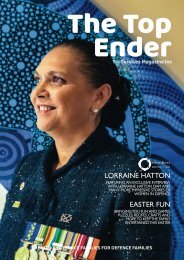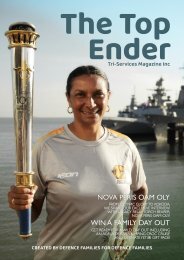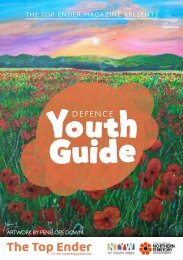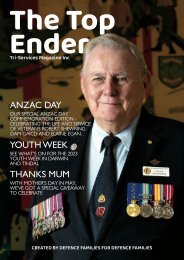The Top Ender Magazine October November 2020 Edition
Oct Nov 2020 Magazine
Oct Nov 2020 Magazine
Create successful ePaper yourself
Turn your PDF publications into a flip-book with our unique Google optimized e-Paper software.
Regular
Hidden Gem
Bare Sand Island: Turtles, Tours and a Tragedy
BARE SAND ISLAND:
TURTLES, TOURS AND A
TRAGIC INCIDENT IN
TERRITORY AVIATION HISTORY
If you are new to Darwin and looking for something really
unique to do, you will probably ask “Where is Bare Sand
Island?” and “Why is it so special?”
To orient and possibly entice you, it is one of a number of
the small islands of the Grose group on the western side of the
entrance to Bynoe Harbour and is some 65km south-west of
Darwin. Can you get there? Yes! It takes time and a few dollars,
by fast tour boat from Darwin Port but is worth every minute and
is a very special experience which
will probably stay with you a lifetime.
It takes time
and a few
dollars, by
fast tour
boat from
Darwin
Port but is
worth every
minute
Bare Sand Island is the nesting
home of Flatback and Olive Ridley
turtles. These wonderful creatures
have been around since the age of
the dinosaurs, no doubt finding their
way to Bare Sand Island as soon as
it emerged from the sea. If born or
‘hatched’ there, these turtles somehow
have the ability to return to
almost the same spot for their breeding
lifetime which may be as long
as fifty years. The nesting season
for a Flatback turtle is usually from
November to January but sometimes they may lay the year
round. She will lay her eggs at intervals over three weeks, on
average, laying about fifty eggs in each clutch. The hatchlings
begin to leave their nests at the beginning of December and
make their way across the sand to the sea, a relatively short but
´ Family members at the crash site. Photo: Betty Franklin. Courtesy of Ralph Duttson.
perilous journey if predators are around! The moment that the
first wave washes over them they start to swim and you can
imagine that they set their inbuilt positioning system to pinpoint
their home or birthplace: if they survive, it is exactly to that spot
they will return, year after year. How their inbuilt GPS works,
nobody really knows but it seems to be almost 100% efficient!
If you take a trip to Bare Sand Island you will find that the
tours are carefully managed by knowledgeable experts, so as
not to disturb ‘the girls’ coming in to lay. It is very upsetting if
there are fishing boats cruising around and frightening them
away. The tours are directly geared to the lunar cycle and are
set to get you there just as the sun is setting and the Moon
rising. Sitting on the sand you will, most times, see at least one
female turtle, emerge from the sea and slowly make her way
up the beach to the soft sand nesting area of her choice. She
can be up to a metre long and weigh up to 90kg so her speed
does not break any records. When she gets to her chosen spot
she will use her flippers to dig a hole into which she lays her
fifty eggs before covering them with sand again, and when
satisfied they are safe and no doubt exhausted, she makes her
way back down to the water. It is a wonderful experience that
you can closely watch, being careful not to disturb or interfere
with her labours. If you use a red light you can photograph her,
under supervision.
She will lay her eggs at intervals
over three weeks, on average,
laying about fifty eggs in each
clutch.
When the eggs hatch, the tiny, toy-like, turtles let themselves
out of the egg, fight their way up through the sand and start their
journey to the sea. It is wonderful to watch but, again, be careful
not to disturb or divert them; they know exactly where they are
going! You will be warned that the turtles are not the only wildlife
18 The Top Ender | Tri-Services Magazine Incorporated


















